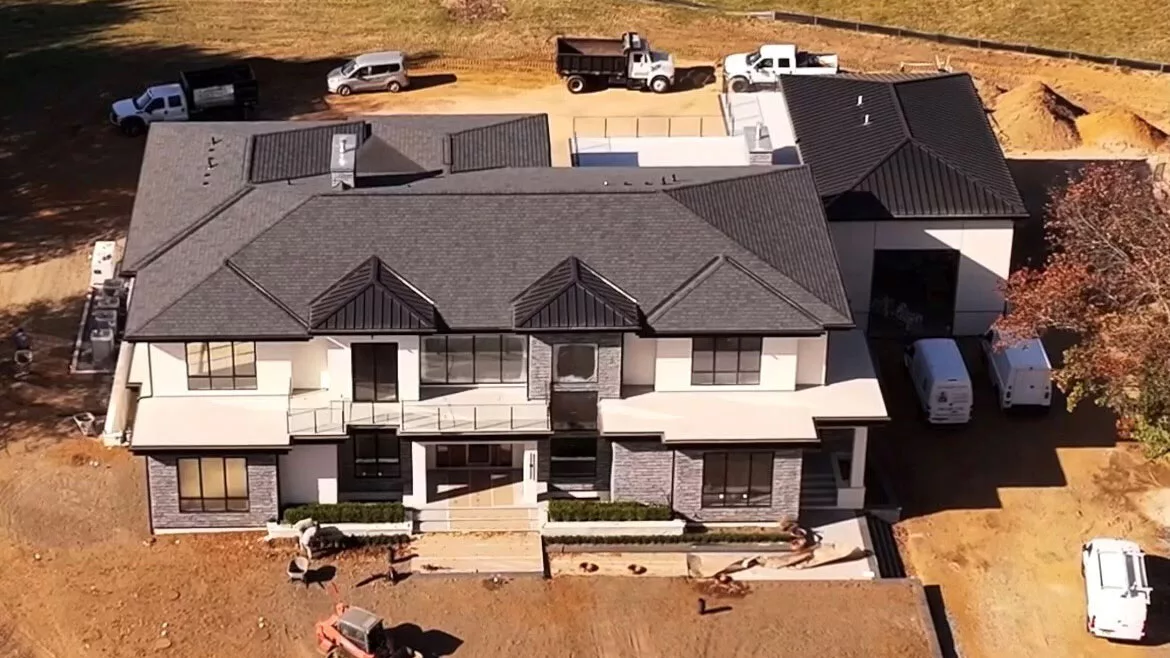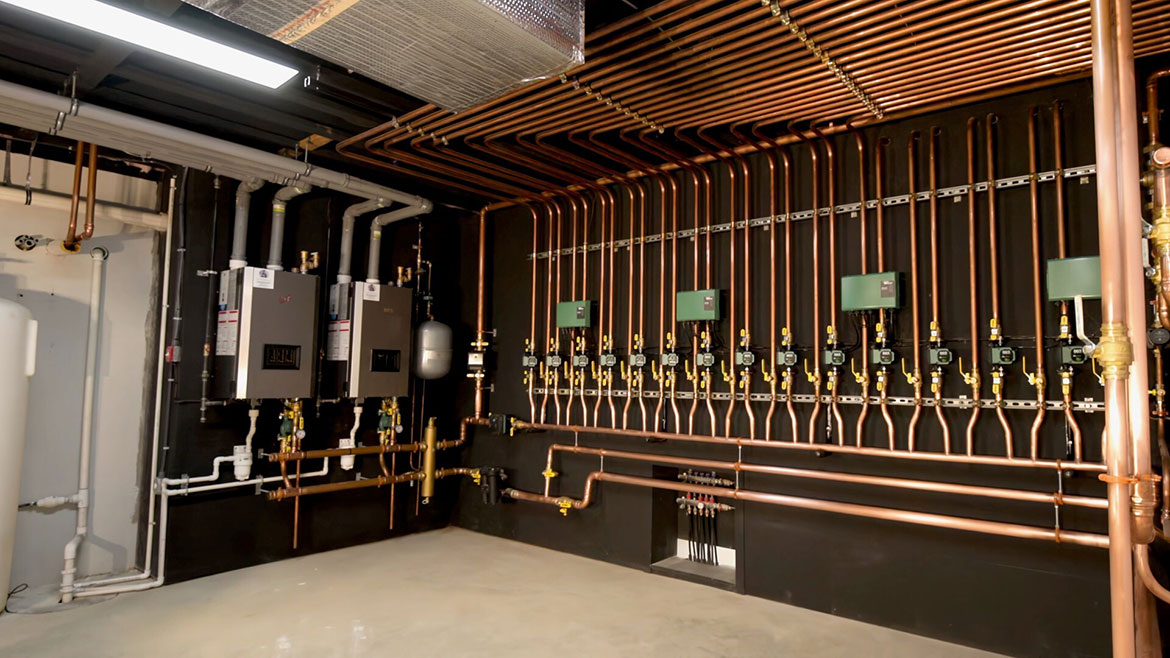Case Study
New Jersey contractor installs radiant system in 15K square foot mansion

NextGen Plumbing, Heating and Cooling designed and installed a radiant heating system for a 15,000 square foot mansion in New Jersey. Photo courtesy of Mercury MC PR agency
As a young and relatively new business owner, Dylan D’Amato had been looking for a signature residential project to establish his company and himself as an industry leader in the competitive New Jersey market. The design, installation and service of a radiant heating system for a 15,000-square-foot mansion will help D’Amato achieve that goal.
D’Amato, the co-owner of NextGen Plumbing, Heating and Cooling, designed and installed the system for the 6-bedroom, 11-bathroom home. The homeowner wanted the cleanest form of heat to help offset the health concerns of a family member living at the home. “After doing some research, the owner knew that he wanted a radiant system,” D’Amato said. “He found a blueprint of exactly how he wanted the home to be built, and he fell in love with it.”
It was up to D’Amato, however, to design and install the elaborate system. “I have done radiant heat projects, and I think it’s the most efficient way to heat the house, especially on a house of this size,’’ D’Amato said. “It really comes down to a technical approach. Radiant heat is super-efficient and will be running at 90 plus percent all winter long.”
Mega mansion
High-end homes are common in some pockets of New Jersey. The home in Colts Neck, where the median single-family home price is $1.2 million, includes two kitchens, a hot tub room and a sauna. The homeowner wanted luxury to exude from every corner of the house.
“He wanted the cleanest form of heat due to health concerns,’’ D’Amato said. “I knew it had to be radiant heat. We had to design the entire system and our experience with radiant systems and the products we offered helped us get the job.”

The system includes to NTI TFTN 150 boilers. The redundant system ensures the homeowner will have hot water supply when boiler needs to be serviced or is temporarily out of operation. Photo courtesy of Mercury MC PR agency
Hydronic systems have been available for centuries and have been the primary source for heating homes in Europe for decades. Hydronic systems are far less popular in homes in the United States, where forced air systems are dominant. In Europe, hydronic heating systems comprise around 60 percent of the market share, while fewer than 10 percent of U.S. homes use hydronic systems.
In a radiant floor system, warm water circulates through flexible pipes embedded under the floor between the joists. As the warmth radiates up from the floor, it warms both people and objects in the room. D’Amato installed products from Viega, which are engineered to reduce energy consumption by as much as 30 percent. The radiant fitting systems deliver consistent temperature by controlling floor and wall temperatures and the Viega system includes all the tubing and connections.
“It’s more efficient because the heat stays close to the floor,’’ D’Amato said. “What it comes down to is there aren’t too many people that are 8 feet tall.”
In addition, radiant heat does not require fans that might blow dust or allergens. “Radiant systems greatly improve air quality,’’ D’Amato said. “The indoor air is much cleaner and easier to breathe. That was particularly important with this client. He wanted something that was clean and super-efficient. Radiant systems are much better for people with disabilities.”
There are several key components to radiant systems, including PEX piping. PEX is more durable than copper, with a predicted life expectancy of 50 years. PEX is also resistant to corrosion, pitting and scaling, and is freeze resistant. It’s also much easier to install because of its flexibility and ability to bend around obstacles. PEX also reduces the risk of leaching harmful substances into the water.

The system also includes two NTI S80 water heaters, which have recovery rates that exceed most industry standard indirects. Photo courtesy of Mercury MC PR agency
Powerful boilers
The heart of the heating system stands in a 5,400-square-foot basement that includes two NTI boilers and two NTI water heaters.
The TFTN 150 boilers provide the heating power for the radiant system, each bringing 138 MBH. Each unit has a built-in zone control that can handle up to three heating zones. The boilers have an EZ Setup Wizard, so programming the boiler is simple. Remote monitoring and diagnostics make the boilers easy to troubleshoot.
“For a job of this caliber, I knew I wanted a premier boiler,’’ D’Amato said. “I knew we’d get better controls and options for the system. I like the TFTN and its features. We could have heated the whole house with one 150K boiler, but I thought it would be better with a redundant system that would provide greater efficiency and would really give the homeowner what he was looking for.”
The redundant system ensures the homeowner will have a hot water supply when a boiler needs to be serviced or is out of operation. When twinned properly, redundant boilers will come online only when needed, which can reduce operating costs. Repairs can also be made on a boiler without completely shutting down access to hot water.
“It’s important on a home of this size to provide a system that prioritizes efficiency,’’ D’Amato said. “The units have a combined 20:1 turndown ratio, so that will help with heating costs. The system also offers full modulation which helps deliver heat while firing at a low input.”
A key component of the NTI boilers is a stainless-steel fire tube heat exchanger, which is widely acclaimed for its quality and durability. The design makes it highly resistant to scale and magnetite formation, and chromium steel makes it highly resistant to corrosion and heat.

The home includes 6 bedrooms and 11 bathrooms, and the homeowner requested a radiant system to help a family member cope with health concerns. Photo courtesy of Mercury MC PR agency
D’Amto also installed two indirect water heaters. The NTI S80 water heaters are among the industry’s highest-performing tanks, with recovery rates that exceed most industry standard indirects. The heaters are manufactured with 444 stainless steel storage tanks renowned for maximum resistance to corrosion, which increases their longevity.
New kid on the block
In the early stages of his career, D’Amato worked in plumbing for a new construction company and later a service company. He joined a start-up to learn how to launch and operate a business and then worked for an HVAC company to diversify his training and experience. Seven-day, 80-hour work weeks were common. He started his business in 2019 with Paul Mailler.
D’Amato and Mailler launched their business shortly before the pandemic, weathered the temporary storm and are now continuing their path to establish themselves as industry leaders in their New Jersey location.
While his career as a business owner is still developing, D’Amato has the mindset to deliver the highest quality craftsmanship to his customers while also providing reliability and transparency.
“We always want to do right by the customer,’’ D’Amato said. “We think treating people fairly and honestly is going to be the best way to grow our business.”
Looking for a reprint of this article?
From high-res PDFs to custom plaques, order your copy today!








